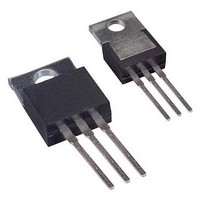TISP3080H3SL-S Bourns Inc., TISP3080H3SL-S Datasheet - Page 10

TISP3080H3SL-S
Manufacturer Part Number
TISP3080H3SL-S
Description
Sidacs Dual Bidirectional overvolt protecter
Manufacturer
Bourns Inc.
Datasheet
1.TISP3070H3SL.pdf
(11 pages)
Specifications of TISP3080H3SL-S
Breakover Current Ibo Max
60 A
Rated Repetitive Off-state Voltage Vdrm
65 V
Off-state Leakage Current @ Vdrm Idrm
0.005 mA
Forward Voltage Drop
3 V
Mounting Style
Through Hole
Package / Case
SIP-3
Lead Free Status / RoHS Status
Lead free / RoHS Compliant
To verify the withstand capability and safety of the equipment, standards require that the equipment is tested with various impulse wave
forms. The table below shows some common values.
If the impulse generator current exceeds the protector’s current rating, then a series resistance can be used to reduce the current to the
protector’s rated value to prevent possible failure. The required value of series resistance for a given waveform is given by the following
calculations. First, the minimum total circuit impedance is found by dividing the impulse generator’s peak voltage by the protector’s rated
current. The impulse generator’s fictitious impedance (generator’s peak voltage divided by peak short circuit current) is then subtracted
from the minimum total circuit impedance to give the required value of series resistance. In some cases, the equipment will require verifi-
cation over a temperature range. By using the rated waveform values from Figure 10, the appropriate series resistor value can be calcu-
lated for ambient temperatures in the range of -40 °C to 85 °C.
The protector can withstand the G return currents applied for times not exceeding those shown in Figure 8. Currents that exceed these
times must be terminated or reduced to avoid protector failure. Fuses, PTC (Positive Temperature Coefficient) resistors and fusible resis-
tors are overcurrent protection devices which can be used to reduce the current flow. Protective fuses may range from a few hundred
milliamperes to one ampere. In some cases, it may be necessary to add some extra series resistance to prevent the fuse opening during
impulse testing. The current versus time characteristic of the overcurrent protector must be below the line shown in Figure 8. In some
cases, there may be a further time limit imposed by the test standard (e.g. UL 1459 wiring simulator failure).
The protector characteristic off-state capacitance values are given for d.c. bias voltage, V
sible, values are also given for -100 V. Values for other voltages may be calculated by multiplying the V
factor given in Figure 6. Up to 10 MHz, the capacitance is essentially independent of frequency. Above 10 MHz, the effective capaci-
tance is strongly dependent on connection inductance. In many applications, the typical conductor bias voltages will be about -2 V and
-50 V. Figure 7 shows the differential (line unbalance) capacitance caused by biasing one protector at -2 V and the other at -50 V.
The protector should not clip or limit the voltages that occur in normal system operation. For unusual conditions, such as ringing without
the line connected, some degree of clipping is permissible. Under this condition, about 10 V of clipping is normally possible without acti-
vating the ring trip circuit. Figure 9 allows the calculation of the protector V
should not be less than the maximum normal system voltages. The TISP3290H3, with a V
ring generators producing 105 V rms of ring on a battery voltage of -58 V. The peak ring voltage will be 58 + 1.414*105 = 206.5 V.
However, this is the open circuit voltage and the connection of the line and its equipment will reduce the peak voltage.
Impulse Testing
AC Power Testing
Capacitance
Normal System Voltage Levels
TISP3xxxH3SL Overvoltage Protector Series
ITU-T K.20/K.21
† FCC Part 68 terminology for the waveforms produced by the ITU-T recommendation K.21 10/700 impulse generator
GR-1089-CORE
(March 1998)
FCC Part 68
Standard
I3124
Peak Voltage
Setting
2500
1000
1500
1500
1000
1500
1500
4000
800
V
Waveform
Voltage
10/1000
9/720 †
9/720 †
0.5/700
10/160
10/560
10/700
2/10
µs
APPLICATIONS INFORMATION
Peak Current
Value
37.5
37.5
37.5
500
100
200
100
100
25
A
DRM
value at temperatures below 25 °C. The calculated value
Customers should verify actual device performance in their specific applications.
Waveform
10/1000
Current
5/320 †
5/320 †
0.2/310
10/160
10/560
5/310
2/10
µs
D
, values of 0, -1 V, -2 V, and -50 V. Where pos-
DRM
of 220 V, can be used for the protection of
25 °C Rating
TISP3xxxH3
Specifications are subject to change without notice.
500
100
250
160
200
200
200
200
A
D
= 0 capacitance value by the
JANUARY 1999 - REVISED JANUARY 2007
Resistance
Series
Ω
0
0
0
0
0
0
0











